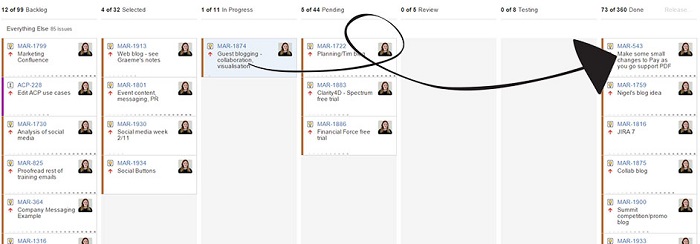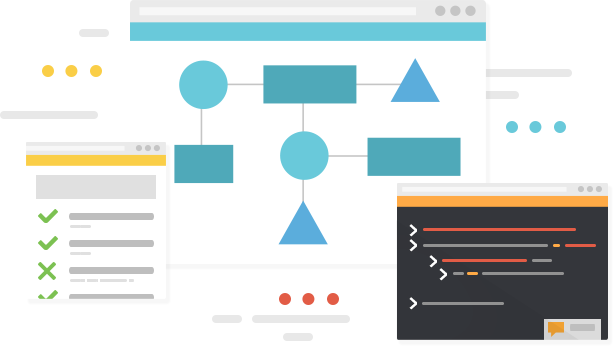
What Are the Ingredients of Effective Collaboration?
Chelsey Lang
Reading time: about 5 min
Topics:
This is a guest post by Chelsey Lang, a Social Media and Marketing Executive for Clearvision.
If there was a definitive answer to “how do we collaborate effectively?” the world would be a much simpler place. Unfortunately, a lot of the time it boils down to “it depends.” Collaboration depends on the people involved, their requirements, the software they use, and the methods of communication they prefer. There are, however, some things we know are essential for effective collaboration. Having worked with enterprise businesses worldwide, as experts in Atlassian’s collaborative tools, Clearvision has experience with all manner of teams and industries. In this post, we’re sharing a few of the lessons we’ve learned about the very fundamentals of collaboration -- lessons that can be applied to every team.
1. It’s all about communication
It’s impossible to work with someone, whether it’s someone in your own team, another team, or even another business, without communicating with them. Poor communication leads to information silos: the dreaded “no one told me that.” At best this slows your organization down; at worst it actively causes you to lose business. We face plenty of challenges when it comes to communication. It’s part of the two-way street of globalization: it’s a great thing to be able to expand your organization and reach new parts of the world, but it makes it increasingly hard to keep in touch with your teams and make sure everyone is up to date and able to work on the go. What should you be focused on? Here are some questions to ask:
- How do you communicate within your team?
- How do you communicate across departments in your organization?
- How your customers communicate with you?
By breaking it down like this, it’s easier to identify where your blocks sit. Once you’ve identified these, you can begin solving them.
2. Information visualisation
We may have oversimplified in that last paragraph. “Solving” a collaboration problem isn’t straightforward, and because of the nature of continuous improvement and agile working, you’ll find there’s always more you can do. It can seem daunting, but this is a good thing! We should always be learning and adapting as best practices and new technologies evolve. One ideal starting point in the road to improved collaboration is to make a shift toward communicating visually. For example, at Clearvision we rely heavily on JIRA Agile kanban boards. Having tangible columns to reflect your workflow clarifies processes to those inside and outside of your immediate team - and everyone loves the feeling of moving a task into the Done column!  Kanban boards help a lot when it comes to prioritization of tasks. It’s easy to build up a bulky backlog, but having the capability to literally drag and drop tasks to rearrange them in priority order makes organizing, or “grooming”, your backlog simple. And at a glance, teams in other departments will be able to understand your different workflows, as well as see how much you have on your plate. (Of course we can’t guarantee that will stop them creating you a JIRA ticket and adding to that work!) The old saying is that a picture is worth a thousand words; that’s definitely the case when it comes to communication. A kanban board is just the first step. Think of all the images you use everyday - diagrams, flow charts, photos, mockups, wireframes. They deliver information clearly and concisely, and they save you more time than you realize.
Kanban boards help a lot when it comes to prioritization of tasks. It’s easy to build up a bulky backlog, but having the capability to literally drag and drop tasks to rearrange them in priority order makes organizing, or “grooming”, your backlog simple. And at a glance, teams in other departments will be able to understand your different workflows, as well as see how much you have on your plate. (Of course we can’t guarantee that will stop them creating you a JIRA ticket and adding to that work!) The old saying is that a picture is worth a thousand words; that’s definitely the case when it comes to communication. A kanban board is just the first step. Think of all the images you use everyday - diagrams, flow charts, photos, mockups, wireframes. They deliver information clearly and concisely, and they save you more time than you realize.  The visualization of work and ideas acts as a common language, something every department in your business will understand. It increases visibility. Not only is information communicated more quickly, but it’s also collected together in one place, so those outside of your team, like stakeholders, are kept in the loop as well.
The visualization of work and ideas acts as a common language, something every department in your business will understand. It increases visibility. Not only is information communicated more quickly, but it’s also collected together in one place, so those outside of your team, like stakeholders, are kept in the loop as well.
3. Choose your tools wisely
The tools you use are the key to truly effective collaboration. Tools are your method of communication. If your information is in a beautifully organized kanban board or an industry standard diagram, but you have no easy way to display it and most importantly discuss it with others, you’re back to being blocked again. So how do you choose the right tools?  Clearvision has some advice in this area. In building Spectrum, a collaborative platform for centralized management of multiple tools and teams, we carefully selected best of breed tools to integrate into Spectrum’s framework. In doing this, we were aware that “best of breed” is liable to change as technology evolves. To combat this we’ve made Spectrum flexible, so it’s simple to adapt and add new tools—and so when making your choice, we recommend thinking about the future. For effective collaboration, you need tools that will scale with you and integrate with any other tools your organization uses. Take the Atlassian tools as an example. We’ve already mentioned Atlassian JIRA, which now comes in three variations: Software, Service Desk and Core, purpose built for dev teams, IT teams and business teams respectively. This means all teams in a business can be working (and collaborating!) on the same JIRA instance, in the same way all teams within a business can contribute to a shared knowledge base thanks to Atlassian’s wiki software, Confluence. Atlassian’s tools integrate with each other (you can update a JIRA ticket from Confluence, for example, or trigger a build in Bamboo from HipChat) but what really pushes Atlassian to the forefront of collaboration is the Atlassian Marketplace. The Marketplace means anyone can build an add-on for the Atlassian tools and make it available to the wider Atlassian community. This means that functionality is always increasing. The Atlassian tools don’t just enable better collaboration, but they’re built around collaboration as well. Obviously, we’re just skimming the surface with this post. There are endless tools, trends and techniques out there to help you with collaboration. What are your favorites? Let us know in the comments - we want to hear your thoughts on what’s in store in the future!
Clearvision has some advice in this area. In building Spectrum, a collaborative platform for centralized management of multiple tools and teams, we carefully selected best of breed tools to integrate into Spectrum’s framework. In doing this, we were aware that “best of breed” is liable to change as technology evolves. To combat this we’ve made Spectrum flexible, so it’s simple to adapt and add new tools—and so when making your choice, we recommend thinking about the future. For effective collaboration, you need tools that will scale with you and integrate with any other tools your organization uses. Take the Atlassian tools as an example. We’ve already mentioned Atlassian JIRA, which now comes in three variations: Software, Service Desk and Core, purpose built for dev teams, IT teams and business teams respectively. This means all teams in a business can be working (and collaborating!) on the same JIRA instance, in the same way all teams within a business can contribute to a shared knowledge base thanks to Atlassian’s wiki software, Confluence. Atlassian’s tools integrate with each other (you can update a JIRA ticket from Confluence, for example, or trigger a build in Bamboo from HipChat) but what really pushes Atlassian to the forefront of collaboration is the Atlassian Marketplace. The Marketplace means anyone can build an add-on for the Atlassian tools and make it available to the wider Atlassian community. This means that functionality is always increasing. The Atlassian tools don’t just enable better collaboration, but they’re built around collaboration as well. Obviously, we’re just skimming the surface with this post. There are endless tools, trends and techniques out there to help you with collaboration. What are your favorites? Let us know in the comments - we want to hear your thoughts on what’s in store in the future!
About the author

Chelsey is a Marketing and Social Media Executive for Clearvision. She writes about agile methodologies, software development, and collaboration and culture in the tech industry. Chelsey is passionate about literature, the intersection of fashion and tech, and the Oxford comma.
About Lucidchart
Lucidchart, a cloud-based intelligent diagramming application, is a core component of Lucid Software's Visual Collaboration Suite. This intuitive, cloud-based solution empowers teams to collaborate in real-time to build flowcharts, mockups, UML diagrams, customer journey maps, and more. Lucidchart propels teams forward to build the future faster. Lucid is proud to serve top businesses around the world, including customers such as Google, GE, and NBC Universal, and 99% of the Fortune 500. Lucid partners with industry leaders, including Google, Atlassian, and Microsoft. Since its founding, Lucid has received numerous awards for its products, business, and workplace culture. For more information, visit lucidchart.com.
